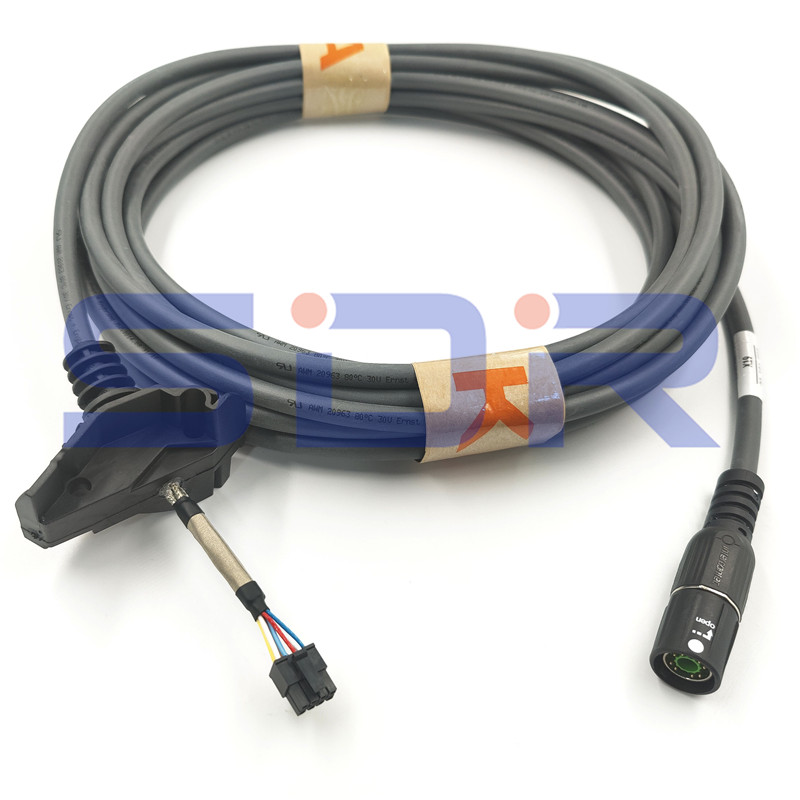The KUKA KRC4 00-181-563 Teach Pendant Cable is a specialized connection component designed for industrial robotic systems. This high-performance cable serves as the critical communication link between the Kuka Robot controller (KRC4) and its teach pendant (SmartPAD), enabling real-time data transmission and operator control.

Connector Type: Proprietary KUKA connectors with gold-plated contacts for optimal signal integrity
Cable Length: Standard 5 meters (16.4 feet), with custom lengths available up to 15 meters
Conductor Material: Oxygen-free copper (OFC) with 99.99% purity for minimal signal loss
Shielding: Triple-layer shielding (foil + braid + drain wire) providing >90dB EMI/RFI protection
Voltage Rating: 300V AC/DC maximum operating voltage
Temperature Range: -40°C to +105°C operational, with short-term peaks to 125°C
Bend Radius: Minimum 8x cable diameter for dynamic applications
Data Rate: Supports KUKA's proprietary protocol at 100Mbps with <1ns latency
The KRC4 00-181-563 cable incorporates several advanced engineering features:
Robust Construction: The cable features a polyurethane outer jacket with a tensile strength of 50N/mm² and abrasion resistance exceeding 500 cycles (DIN 53516). This construction withstands industrial environments including exposure to oils, coolants, and mild chemicals (resistant to ISO 1817 standard fluids).
Signal Integrity: With a characteristic impedance of 100Ω ±5% and capacitance of 80pF/m, the cable maintains signal quality even over extended runs. The twisted pair configuration reduces crosstalk to <-60db at="" 100mhz.="">
Flexibility: The cable's high-strand count (19x0.12mm per conductor) and specialized insulation allow for >5 million flex cycles at the rated bend radius, making it suitable for continuous robotic motion applications.
The KUKA KRC4 teach pendant cable finds application in numerous industrial automation scenarios:
Automotive Manufacturing: In body-in-white (BIW) welding lines where the cable must withstand sparks, metal particulates, and frequent robotic repositioning. The EMI shielding prevents interference from nearby resistance welding equipment operating at 10-50kA.
Aerospace Assembly: For large-component positioning systems where extended cable lengths (up to 15m) maintain signal integrity across expansive workcells. The cable's temperature range accommodates both climate-controlled clean rooms and unheated hangars.
Pharmaceutical Packaging: In sterile environments requiring frequent wipe-downs with isopropyl alcohol or hydrogen peroxide solutions. The cable jacket's chemical resistance prevents degradation from cleaning protocols.
Foundry Operations: Where ambient temperatures near casting lines can reach 80°C+ and the cable must resist thermal cycling without performance degradation. Special high-temp variants are available for extreme environments.
Proper installation ensures optimal performance and longevity:
Route cables away from high-voltage power lines (>600V) maintaining at least 300mm separation
Use strain relief at both ends to prevent connector damage - KUKA recommends their ST-45 strain relief system
When running through cable carriers, maintain the 8x diameter bend radius and limit acceleration to 4m/s²
For vertical runs, support the cable every 1.5 meters to prevent conductor stress
Label both ends with KUKA-approved markers (P/N 00-123-456) for traceability
Regular maintenance preserves cable performance:
Visual Inspection: Perform bi-weekly checks for jacket abrasion (measure depth with ISO 4637 gauge), connector corrosion (check for >5% contact area oxidation), and strain relief integrity.
Electrical Testing: Quarterly tests should include:
Continuity check with <0.5Ω resistance end-to-end
Insulation resistance >100MΩ at 500VDC (per IEC 60243)
Shield effectiveness test showing <3% signal attenuation at 100MHz
Cleaning Protocol: For contaminated cables:
Non-flammable contaminants: Use KUKA-approved cleaner (P/N CL-200) with lint-free wipes
Oil-based residues: Apply isopropyl alcohol (70-90% concentration) followed by compressed air drying
Never use abrasive pads or solvents containing ketones
Common issues and diagnostic steps:
Intermittent Connection:
Check for broken strands using micro-ohmmeter (look for >10% resistance variation between conductors)
Inspect connectors for bent pins (maximum 0.1mm deviation from centerline)
Test under motion - use oscilloscope to monitor signal integrity during robotic movement
EMI Issues:
Verify shield termination - should show <1Ω resistance to ground
Check for shield damage using time-domain reflectometer (TDR) looking for impedance spikes >120Ω
Ensure proper grounding of both controller and pendant (earth bond <0.1Ω)